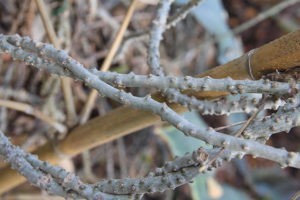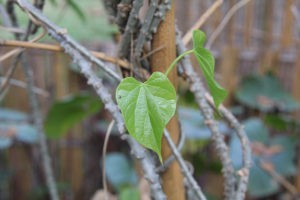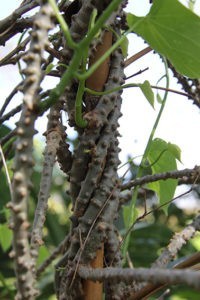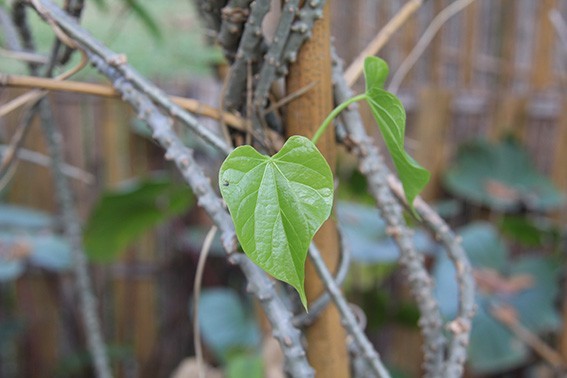Scientific name: Tinospora crispa
English common name: Quinine plant, bitter plant
Lao name: Khao ho, kheua
Plant family: Menispermaceae (Moonseed family)
This plant is in the Menispermaceae family – without doubt the most well-known of this family for its medicinal virtues, even outside of its natural range. One only needs to read the popular names it has been given in different languages to see this.
This woody vine is recognizable by its stalks, which are studded with numerous knobs. Its leaves are heart-shaped, the flowers have three petals, and the fruit are elongated drupes. The stalks contain a very bitter, milky sap. The quinine plant grows in the humid forests of Southeast Asia, normally above 1000 m. It is native to Laos and Cambodia, but it was introduced to Vietnam by the Sisters of Saint Vincent de Paul to fight rebellious fevers.

The knobs can clearly been seen on the stem here.
In Laos it is grown in many gardens and is fast-growing in hot weather (growing at a rate of 25 cm in 24 hours). If it cannot be found growing in a particular area, you will not have any difficulty in buying it, since it is sold everywhere in Laos, including at the markets, and by street vendors.
The vine is an important plant in traditional medicine; its strong bitterness has lead to its use as an aperitif and digestif; it is recommended in cases of rheumatism, tetanus, syphilitic canker sores, diabetes, and above all for the treatment of all fevers, particularly for malaria.
In Laos it is also said that kheua khao ho is good for older people. To live a long life you must eat a little bit of this vine everyday (with a little sugar to lessen the bitterness).
After sun-drying the vine, one can make a powder to use as a medication; it is added to the food of horses and buffalo to make them gain weight. This same powder, added to lotion, slows down ageing when applied to the skin.

New leaves have just started to grown on this quinine plant at PTK.
None of these traditional uses have been verified by science, but ethnopharmacology (the study of remedies used by different cultures) has sometimes found avenues for the use of plants in modern medicine. Malaria treatment drugs are a good example of this – studying plants traditionally used in their treatment led to the modern drugs we use today.
Researchers are always hoping to find new plants with medically effective molecules, and they have high hopes for the study of the quinine plant due to its importance in traditional medicine.
Text by Dr Biba Vilaylek, PTK Ethnobotanist. Translation from French kindly done by Gillian Marshall. Edits and photographs by Bryony Smart,
PTK Botanist.

The twining habit of the plant can be seen here.



